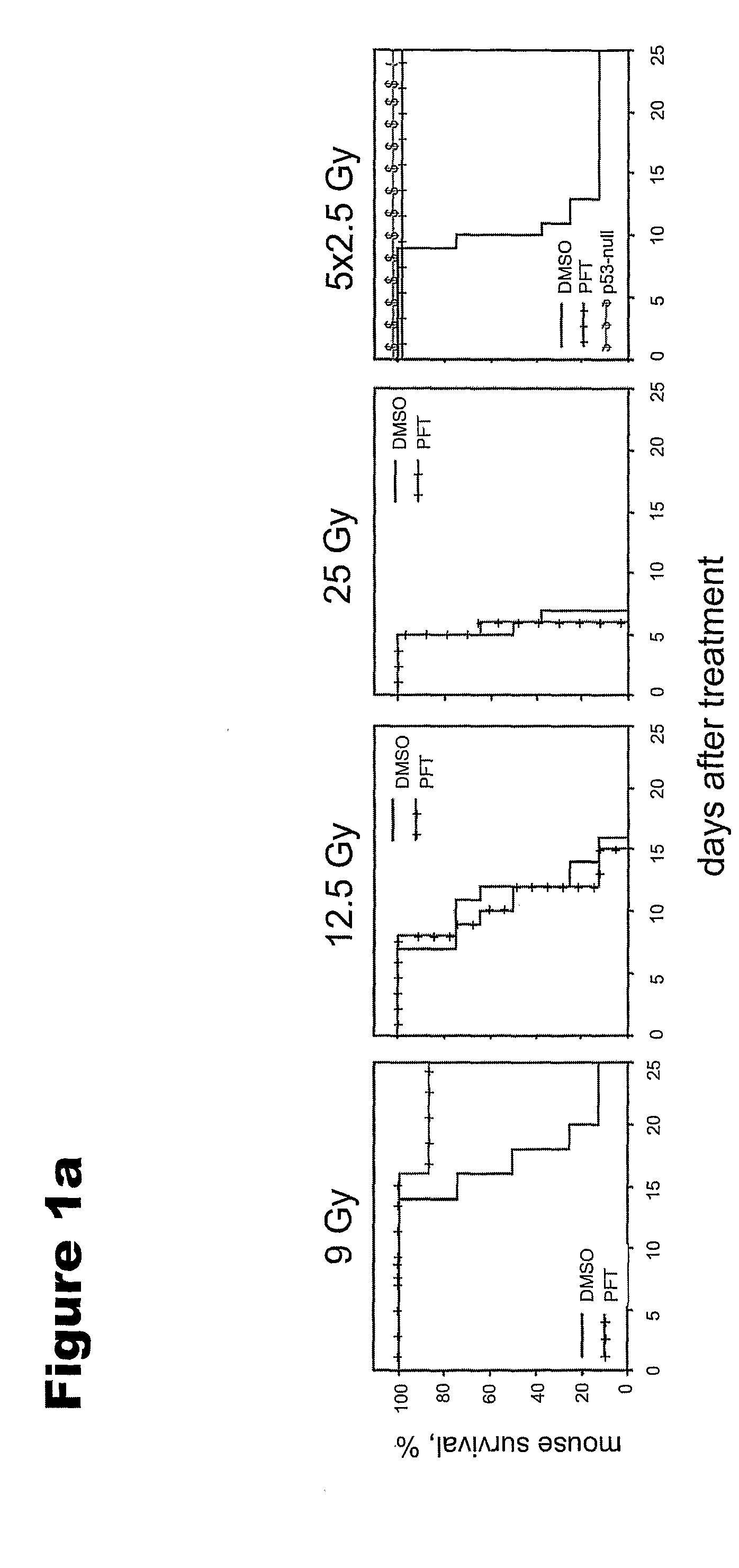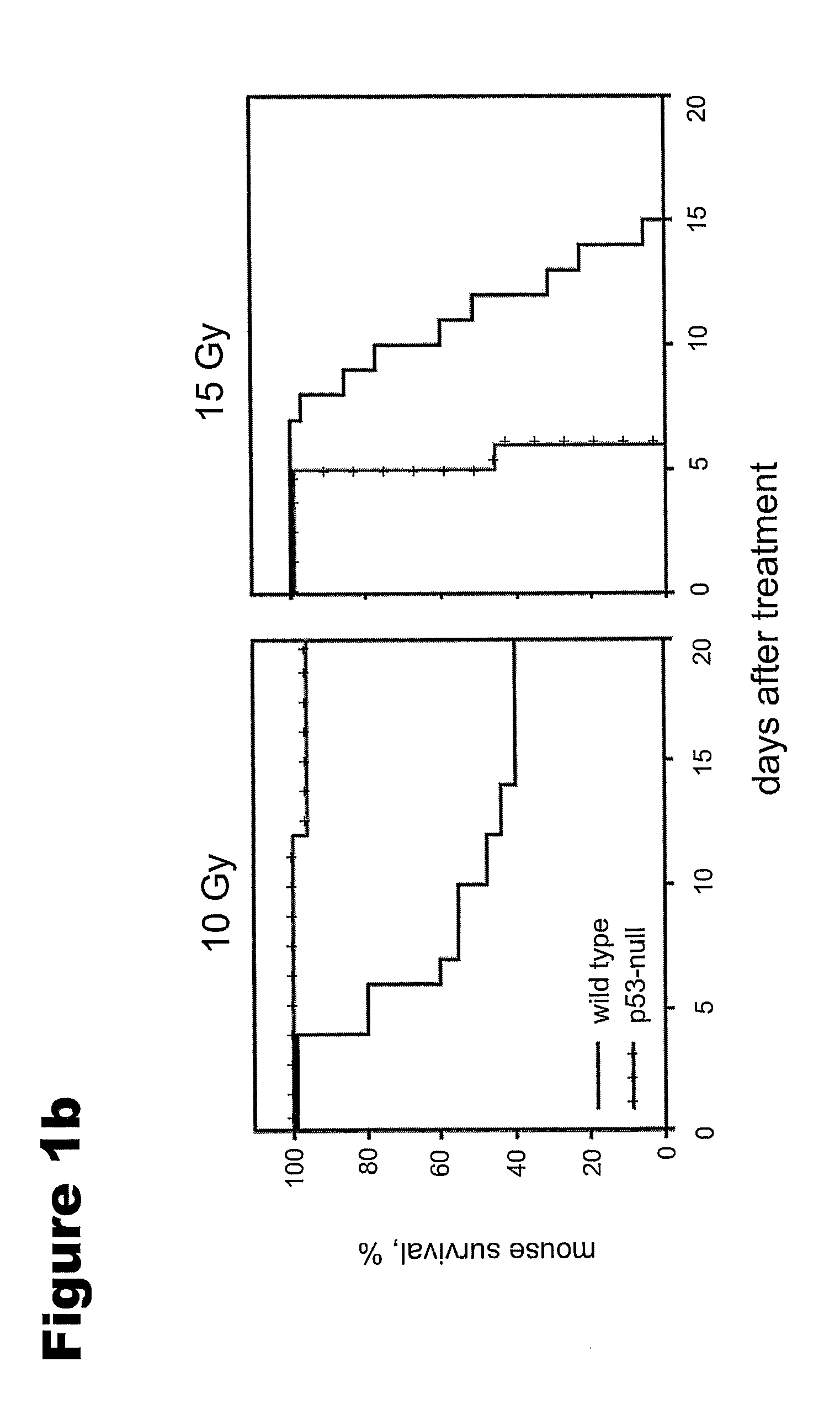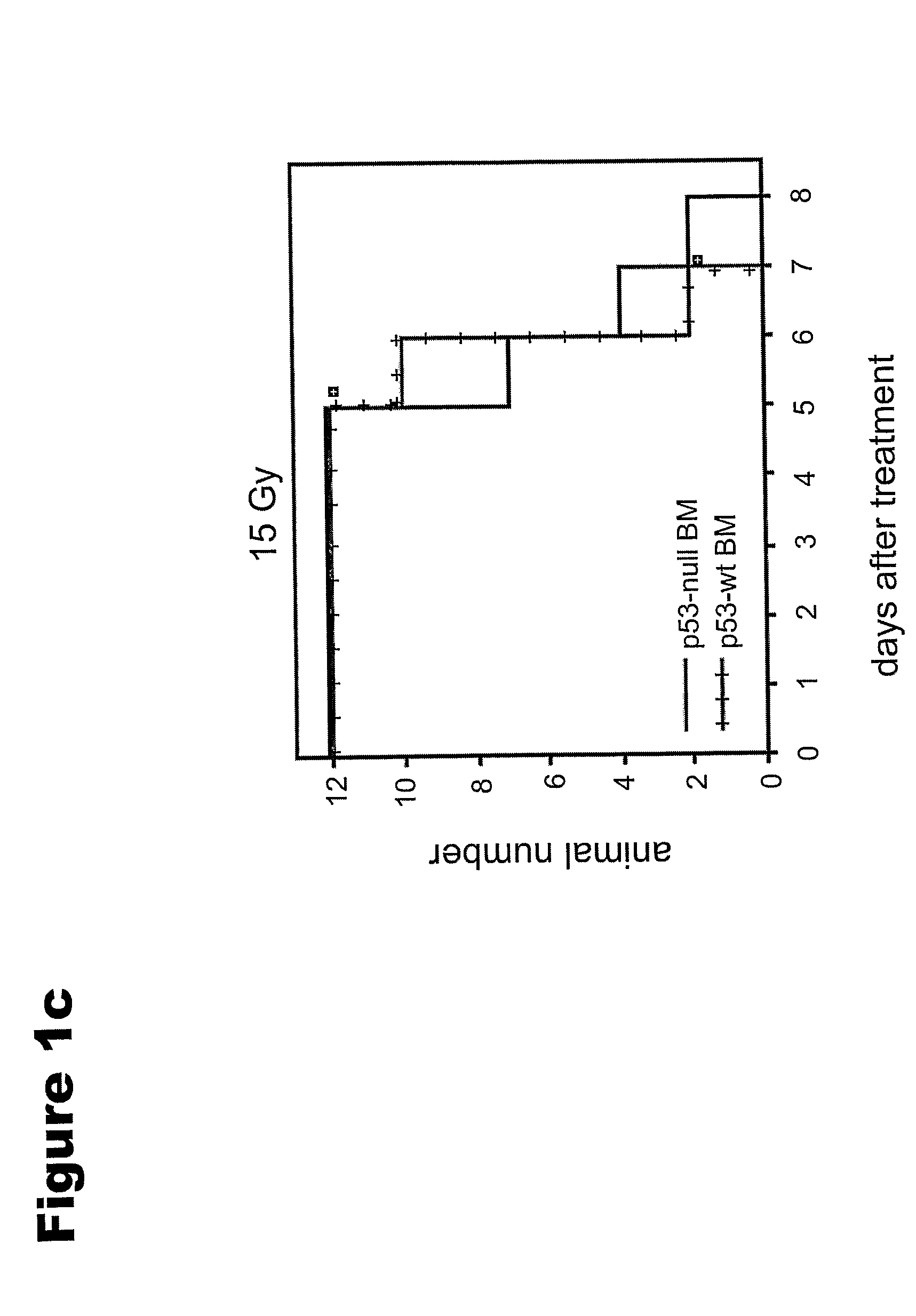[0127]CBLB601, a R-Pam2-
lipopeptide with the
peptide moiety consisting of C-SKKKK (SEQ ID NO: 8), was selected for more detailed characterization as a radioprotector based upon its ability to activate NF-κB and preliminary
in vivo data on radioprotection in NIH-SWISS mice (see Example 2). The objectives of this study were to determine the optimal
dose,
route of administration, and time of administration of CBLB601 to serve as a protector. ICR female mice of 10-15 weeks of age were used, with 10-15 animals per group or condition.
[0128]The
dose of NOAEL (No Obvious Adverse Effects Level) was determined by injecting intraperitoneally (i.p)
ICR mice with the increasing doses of CBLB601 (0.3, 1, 3, 10, 30, 60, 100 μg / mouse). Control mice were injected with PBS. The mice were observed for two weeks. During the first week they were weighed daily. There were no differences in weight between the CBLB601-treated and control mice. Mortality was observed 1-2 days post-treatment at the 100 μg of CBLB601 / mouse, but not at any of the lower doses. However, at 60 μg
dose, the mice showed signs of morbidity, such as
slow motion and scruffy fur, around 3-4 days
after treatment. At the 30 μg dose, there were no noticeable differences between the treated and control mice. Thus, NOAEL for CBLB601 was determined to be 30 μg / mouse.
[0129]The optimal intraperitoneal administration schedule of CBLB601 was determined by injecting the compound at different times prior to
irradiation. Previously, it was found that CBLB601 was protective against 10 Gy but not higher
irradiation doses (see Example 2). Therefore, all of the optimization experiments were performed with 10 Gy of total body
irradiation (TBI). A dose of 3 μg of BCLB601 / mouse (1 / 10 NOAEL) was chosen as the starting dose. Thus, 3 μg of CBLB601 was injected i.p. into
ICR mice at 0.5 h, 1 h, 6 h, and 24 h or 1 h, 24 h, 48 h, 72 h, 96 h prior to 10 Gy of TBI (as described in Example 1). Following irradiation, the mice were observed for 30 days and their survival was recorded. The results of these experiments are summarized in FIG. 5. Injection of CBLB601 24 hrs before irradiation clearly yielded the best radioprotection (90-100% 30-day survival). When the compound was administered 48 hrs before irradiation, the radioprotection was ˜30%. Administration of CBLB601 at 1 hr prior to irradiation produced inconsistent results
ranging from 80% protection in one experiment (FIG. 5B) to almost no protection (20%) in another experiment (FIG. 5A). No radioprotection was observed when the
drug was administered at 0.5 h (10%), 6 h (20%), 72 h, and 96 h prior to TBI.
[0130]To determine the optimal radioprotective dose of CBLB601, the timing of injection and level of irradiation were kept constant, while the dose of CBLB601 was varied.
ICR mice were injected i.p. with 1, 3, 10, 20, or 30 μg of CBLB601 / mouse or 0.1, 0.3, 1, 3, 10, or 15 of CBLB601 / mouse 24 hrs prior to irradiation (10 Gy of TBI), and their survival was monitored for 30 days. The best protective dose was 3 μg / mouse, which supported a survival of 100% (FIGS. 6 A and B). Almost similar
efficacy was reached with the 1 and 10 μg / mouse doses, which rescued 90% of the mice (in one experiment). In contrast, higher doses of CBLB601 (20 and 30 μg / mouse) led to accelerated mortality when administered in combination with irradiation, as compared to PBS injected control mice. Some signs of this combined
toxicity were detectable already at the 10 μg / mouse dose. Thus, the optimal protective dose of CBLB601 was determined to be 3 μg / mouse. Thus, while it appears that CBLB601 conferred radioprotection at doses 10-30-fold lower than the NOAEL, the margins of safety of CBLB601 were significantly reduced when CBLB601 was administered in combination with irradiation.
[0131]To determine the level of
radiation that was protected by CBLB601, radioprotectant-treated and control mice were exposed to increasing levels of TBI. Groups of ICR mice were injected i.p. with either 3 μg CBLB601 / mouse or PBS, and then 24 h later they received 10, 11, 12, 13, 14, and 15 Gy doses of TBI. Survival was recorded over 30 days. FIG. 7A shows the
radiation dose-dependent mortality of mice injected with PBS. All of the mice irradiated with 10-11 Gy of TBI died between days 12-14 post irradiation, which was typical for death due to hematopoietic failure. All of the mice that received 14-15 Gy of TBI died between days 7-9 post irradiation, which was typical for mortality due to radiation-induced intestinal damage. Mice that were irradiated with 12-13 Gy of TBI died at intermediate times, which was typical for a mixed
etiology of radiation-induced mortality. FIG. 7B shows the
radiation dose-dependent mortality of mice pretreated with CBLB601. Mice injected with 3 μg of CBLB601 24 hrs prior to irradiation were, as expected, fully protected from 10 Gy of TBI. Despite the obvious differences in survival between the control and treated mice, the protective effects of CBLB601 did not reach
statistical significance under this setting. To reach a statistically significant 10% difference between control and CBLB601-treated mice, experimental groups of at least 50 mice must be used. Although CBLB601 rescued 100% of mice from 10 Gy of TBI, its protection at 11 Gy of TBI was only 20%. There was no protection from irradiation at levels higher than 11 Gy, indicating that CBLB601 was unable to rescue animals from the gastrointestinal component of radiotoxicity. Moreover, at irradiation doses of 11, 12 and 13 Gy, the CBLB601-treated mice died with an accelerated
kinetics, i.e., similar to those that received 14-15 Gy doses, as compared to PBS-injected control mice. This may be indicative of a combined
toxicity of the
drug and the irradiation. Thus, it appears that at higher irradiation levels, CBLB601 did not confer protection and it was also more toxic.
[0132]CBLB601 was administered intramuscularly to determine the
optimal route of administration of this compound (especially since this would be the preferred
route of administration for humans). FIG. 8 shows the survival rates of mice injected intramuscularly (i.m.) with 1, 3, or 10 μg of CBLB601 / mouse 24 hr before irradiation. All three doses of CBLB601 imparted radioprotection; and there was no sign of combined
toxicity at the 10 μg / mouse i.m. dose, as there was for the 10 μg / mouse i.p. dose (FIG. 6). In another experiment, increasing doses of CBLB601 administered i.m. were tested against 10, 11, and 12 Gy doses of HBI (FIG. 9). There was a non-statistically significant shift to increased mortality of mice injected with the higher doses (10, 30 μg) of CBLB601 prior to
exposure to 10 Gy of TBI. A summary of the dose-dependency of the radioprotection of CBLB610 administered i.p. or i.m. 24 h prior to 10 Gy of TBI is shown in FIG. 10. From these data, it was concluded that the i.m.
route of administration was as effective as the i.p. route, and the optimal dose (3 μg / mouse) was the same for both routes of administration. Moreover, it was concluded that i.m. delivery may be
safer because it had a higher
therapeutic index (
toxic dose / effective dose): 10-30 for i.m. administration (FIGS. 8 and 9: 30 μg / mouse / 1-2 μg / mouse) vs. 3-10 for i.p. administration (FIG. 6: 10 μg / mouse / 1-3 μg / mouse). Additionally, recalculation of the effective dose per
body weight revealed a smaller window for intraperitoneal delivery compared to intramuscular delivery; i.e., 90-110 μg / kg for i.p. delivery and 60-115 μg / kg for i.m. delivery (FIG. 11).
[0133]The optimal schedule of intramuscular administration of CBLB601 was determined by varying the time between
drug delivery and irradiation. ICR mice were injected i.m. with 3 μg of CBLB601 / mouse 24 h, 6 h, 3 h, and 1 h prior to TBI and +1 h, +3 h after TBI (FIG. 12A), as well as 48 h, 36 h, 24 h, 12 h, and 6 h prior to TBI (FIG. 12B). These experiments revealed that, similar to the
intraperitoneal route of delivery, the optimal time for intramuscular delivery of CBLB601 was 24 h prior to 10 Gy of TBI. Intramuscular administration of 3 μg of CBLB610 / mouse after (1 h and 3 h) 10 Gy of TBI had no protective effect (FIG. 12A). Moreover, higher doses of CBLB601 (10 and 30 μg / mouse) injected i.m. 1 h after 10 Gy of TBI caused increased levels of combined toxicity (FIG. 13C). These data are summarized in FIG. 13.
[0134]To determine DMF (dose
modification factor), 3 μg of CBLB601 / mouse was injected i.m. 24 hr prior to irradiation and control mice were injected with PBS. Both drug-injected and control groups received a single dose of TBI covering the dose range that leads to 10-90% mortality within the chosen time intervals (7 days for the gastrointestinal syndrome mortality, and 30 days for the hematopoietic syndrome mortality). The percent mortality-
radiation dose graphs were built and LD50 / 7 and LD5 / 30 (LD50 at 7 days and 30 days, respectively) were calculated using
probit or
logit statistical analysis. DMF (also known as
dose reduction factor, DRF) was calculated as a ratio of radiation LD50 for CBLB601-treated groups and radiation LD50 for vehicle-treated groups of mice for the chosen survival time point, 7 or 30 days. To calculate DMF30, which is the DMF at day 30 post-irradiation, the radiation LD50 / 30 values for mice treated with PBS or 3 μg of CBLB601 was determined. For this, PBS-injected groups were irradiated with doses of 6, 6.5, 7, and 7.7 Gy of TBI, and CBLB601-injected groups were irradiated with doses of 10, 10.5, 11, 11.5, and 12 Gy of TBI. The LD50 / 30 for CBLB601 was calculated using
ProBit analysis and was estimated to be in the range of 11.07-11.61 Gy, with the average of ˜11.32 Gy (see FIG. 14). However, inconsistency in the response to some radiation doses (7 Gy appeared non-toxic whereas 6.5 Gy caused 60%
lethality at 30 days) in the control mice precluded an accurate calculation of the DMF30 for CBLB601. Nevertheless, it was expected that the LD50 / 30 for ICR mice was around 7 Gy [an average for the majority of mouse strains; Monobe et al., Radiother
Oncology 73 Suppl 2: S12709, 2004)]. Thus, the value of DMF30 for CBLB601 was estimated roughly as ˜1.6.
 Login to View More
Login to View More 


